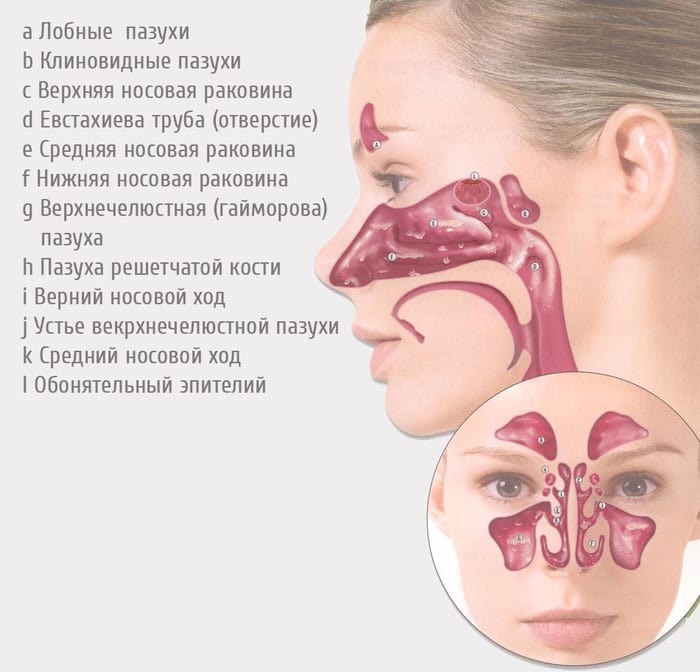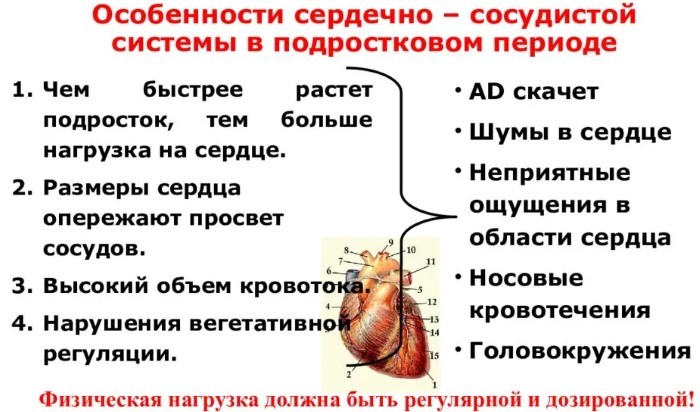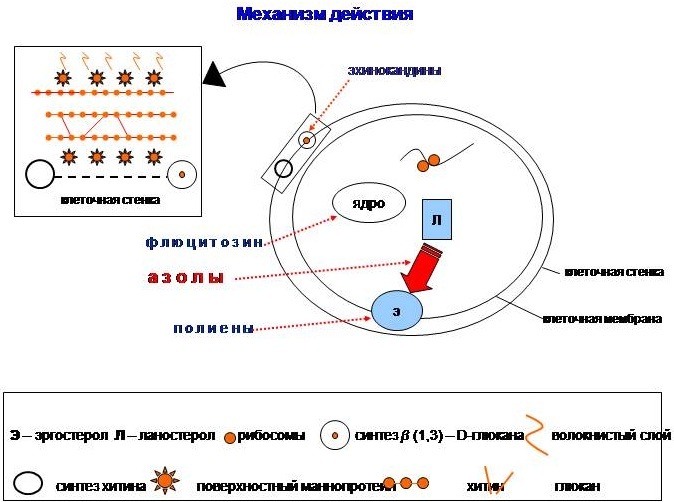Content
- How to take blood from a vein in infants
- Physiological preparation of children
- Where does the blood come from
- Procedure step by step
- Tips for parents
- In children under 4 years of age
- Physiological preparation of children
- Psychological preparation of children
- Where does the blood come from
- Procedure step by step
- Tips for parents
- Video about blood from a vein to a child
Blood from a vein in children for the first time they are taken in the first hours after birth. And in the future, periodically, either from a finger or from a vein, a fence is made regularly: during an illness or after an illness, during a medical examination or before a planned surgical intervention.
Venous blood allows you to assess the state of work of all systems and organs of the child, to establish the blood group. But before passing the analysis, adults need to know about all the nuances of the procedure and the preparatory stage so that the analysis is accurate and as informative as possible.
How to take blood from a vein in infants
They take blood from a vein from children only on an empty stomach, so it is better to visit the laboratory in the morning so that after the procedure the baby can eat normally. It can be quite difficult to follow such a rule with a baby. But if it is very important to obtain undistorted data, for example, to find out the concentration of glucose in the blood, then you should definitely consult with your pediatrician in order to carry out the procedure without discomfort for baby.
Physiological preparation of children
In order for the results of the blood test to be as accurate as possible, it is imperative to properly prepare for its delivery. 24 hours before the intake, the diet should be revised: exclude heavy, high-fat and sweet foods from it. For 8-10 hours before donating blood, you need to not eat, sampling is carried out only on an empty stomach, but babies are an exception.
Some studies suggest eating 2 hours before visiting the lab.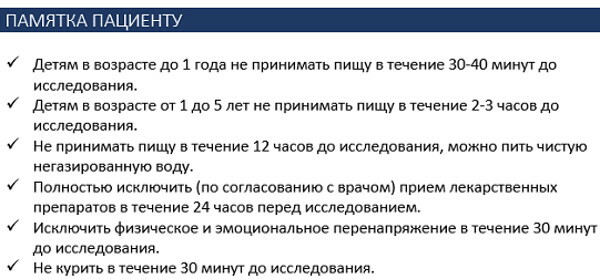
As for children under one year old, they have some differences regarding the preparation for donating blood:
- Blood is drawn from infants 3 hours after the last feeding and before the next meal. The time of the analysis does not depend in any way on whether the baby feeds on breast milk or formula. This period of time is essential to obtain accurate data.
- Due to the fact that the baby has a natural thickening of the blood, then before passing the test, you need to give him a drink of purified water and without gas. It will be enough only 2 tbsp. l. water and take blood from the vein will be much easier. Do not give juices or soda.
- 2 days before blood sampling, you need to stop giving your child medications.
- Blood from a vein should be donated after an instrumental examination.
- If the child is not healthy, very excited, then it is better to postpone the analysis to any other day.
Where does the blood come from
Blood is taken from a vein in infants only in a laboratory.
The fence can be carried out from different places:
- most often, a specialist makes a fence from a vein in the elbow area;
- sometimes it can be a vein located in the forehead or head;
- a vein on the forearm is also suitable for a fence;
- palms are good for this, but only the back of them;
- calf legs.

If it is not possible to draw blood from the baby from the cubital vein, then choose any other.
Procedure step by step
They take blood from children only in a specialized room, where everything is sterile. The skin at the site of the localization of the vein, from which it is planned to take a fence, is treated with an antiseptic composition. A tourniquet is applied to the arm above the elbow joint. For sampling, only a disposable needle is used, and the material intended for research is poured into a sterile test tube.
Modern centers for conducting blood tests have recently been using vacuum tubes and plastic, and each of them is designed for a specific type of analysis. Often, the site of the future vein puncture is lubricated with special ointments that have an analgesic effect. During the puncture of the skin and vein, the child almost does not feel discomfort and behaves calmly.
When the fence is made, the tourniquet is removed, and the needle is removed from the vein. A sterile napkin, pre-moistened with an antiseptic, is applied to the puncture site. It is pressed tightly to the puncture site. You can fix the napkin with an elastic bandage.
Sometimes, in order to minimize painful sensations, blood for analysis from a vein is taken with a butterfly needle, which is supplemented with a long catheter and two restraints resembling butterfly wings.
These needles are actively used when taking analysis from children of any age, but they are especially often used for babies. Thanks to the tight fixation of the catheter, you can easily take blood even from an active crumbs. The main advantage of using a catheter is minimal tissue trauma. These needles are widely used in intensive care units.
Tips for parents
They take blood from a vein from children, and parents worry most of all, worrying about their baby.
But don't worry, here are some helpful tips to help adults prepare:
- It is better to take the analysis in a proven clinic with experienced staff.
- If during the procedure a specialist asks the parents to leave the room, then there is nothing to worry about. Why unnecessary nervousness, the specialist knows his business, the procedure will be carried out exactly in accordance with sanitary standards.
- To help your child get distracted, you can take their favorite toys with you when you go to the laboratory. They will distract and help you quickly forget a not very pleasant procedure.
- After the procedure, the child needs to feel comfortable: hug, kiss. You can return home together to watch his favorite cartoon, read a book to him or assemble a pyramid. All these emotions will help you to relax and forget about the transferred procedure.
- Taking blood is not a very pleasant process for an adult, and even more for a child. The pain at the puncture site will lead to discomfort, but it will disappear without a trace in a few minutes. An adult should become an example for the baby, no panic, peace will be passed on to the child.
Not always, but in rare cases, complications can be observed after taking blood from a vein, and the most common of them is the formation of hematomas and bumps. Parents should remember that such complications are not evidence that the baby's blood was not taken by a professional. A hematoma may appear due to the fact that the vessels in the baby are rather fragile, they are located deep, the baby's body is dehydrated.
In order for the healing to take place quickly, a cold compress should be applied to the site of the hematoma or lump. If the problem persists within a week, the child additionally has a high fever and edema, then this should force adults to urgently go to the hospital.
In children under 4 years of age
A blood test is an important point in helping to establish a diagnosis. It helps to monitor the effectiveness of treatment. For research, they take not only blood, but also urine, saliva and other secretions, but everything starts with blood test, since it is this liquid that washes all organs in the body and allows you to quickly identify ailment.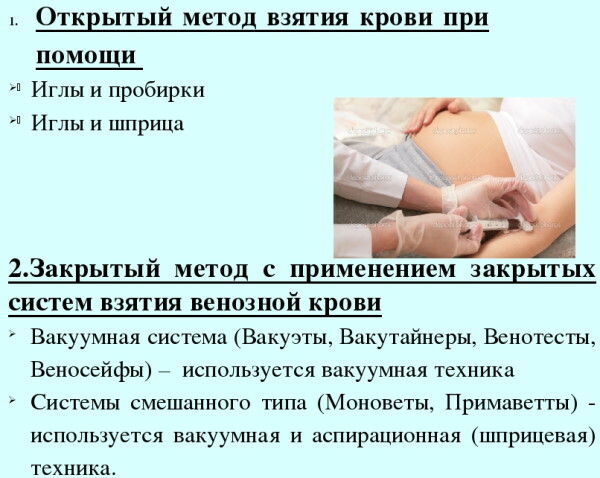
Blood can be taken from a finger or a vein, but more often venous fluid is taken, since this analysis is more informative. There are several tests that require blood from a vein, and each of them makes it possible to see abnormalities.
| Biochemical analysis | With its help, it is possible to assess the work of internal organs: liver, kidneys. |
| Serological analysis | It helps to identify the pathogen that caused the development of the disease, and helps to choose an effective treatment. |
| Allergen analysis | This analysis allows you to choose the right food, removing allergens from it or removing objects that provoke allergies from the child. |
| Immunological analysis | It allows you to assess the hormonal background, to determine how much the body is saturated with nutrients, to assess the genetic predisposition to various ailments. |
Physiological preparation of children
To obtain more reliable data from a laboratory study of venous blood, you need to know how to properly prepare for blood sampling. The day before visiting the laboratory, it is worth providing the child with dietary food. Everything cooked by the fried method is removed from it, as well as dishes with a high level of fat content. Remove sugary foods from the diet.
The child should not eat for 8 hours before blood sampling. In the morning, the child should come to the laboratory hungry, because the analysis is given on an empty stomach. If you neglect this rule, then the analysis results will be distorted.
The best time for taking the test is in the morning, the norms of all laboratory tests were developed with the condition that the sampling was carried out from 8 to 11 in the morning.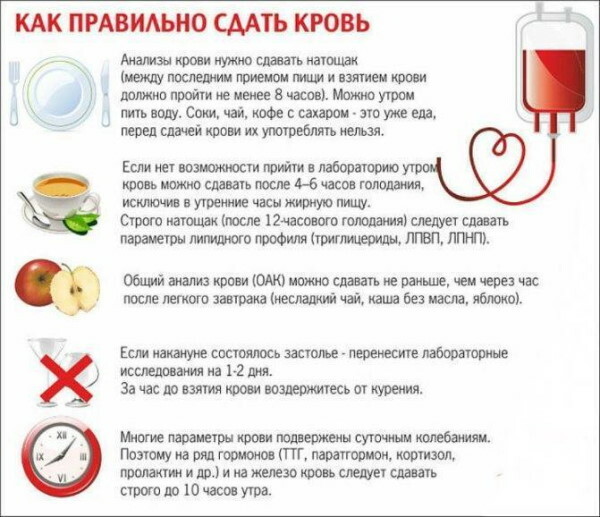
Half an hour before blood sampling, the child should be given 1 / 2-1 tbsp to drink. water, but only without gas. Juice and tea should not be given to a child. The fluid will help improve blood flow.
Psychological preparation of children
Before visiting the laboratory, where they will take blood from a vein, it is imperative to talk to him. If the parents remain completely calm and calm, then the little patient himself will feel confident when sowing.
A child who already goes to kindergarten or has reached school age needs to be explained that a medical worker will accompany him in the office. If the child has previously donated blood from a finger, then he should be explained that the analysis from a vein differs in that it takes more time. It is also worth warning that the discomfort may be stronger than when taking a biological fluid from a finger.
Sometimes you may need to give your child an example, such as telling the child that taking blood is similar to a mosquito bite. Such comparisons will help the child figure out what will happen to him and set him up in a calmer mood.
The preparatory stage should take place in a playful way. During the game, the kid will be able to relax and accept all the information that the specialist tells him. If parents want to properly prepare the baby for the procedure, then you can play with him in the hospital. During the game, you can accurately depict the procedure, step by step studying all the moments that will happen to him in the laboratory.
Small children who are only 1-4 years old can be distracted from manipulation. You can take his favorite toy with you or buy something new the day before, so that he thinks not about the manipulation itself, but about the fact that he will soon be allowed to play with a new toy.
Where does the blood come from
They take blood from a vein in children located in the elbow bend or in the palm, but only from its back. If the veins are poorly visible, then the fence can be drawn from a vein located on the forearm, the back of the foot, or even from a vein on the head.
Procedure step by step
Venous blood has long been used for accurate diagnosis and treatment adjustments. Initially, the fence was carried out with an ordinary disposable syringe, but today everything has changed dramatically and unique devices have appeared - vacuum systems.
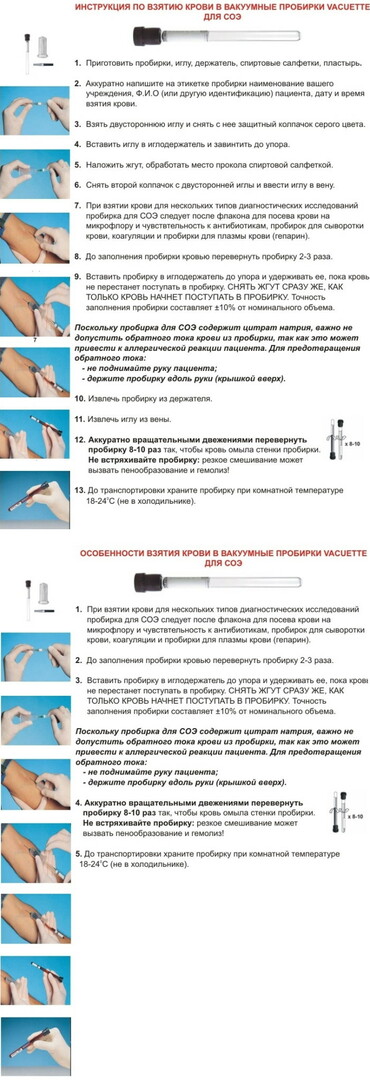
Thanks to such systems, it is possible not only to take blood from a vein safely for a child or an adult, but also to make this method one of the most effective. Vacuum tubes, or as they are often called vacutainers, help to carry out the procedure efficiently.
Vacutainers or three-piece system consists of:
- a sterile tube filled with a preservative;
- a bilateral automatic needle for intravenous injection;
- automatic needle holder.
The advantages of using vacuum systems in children are obvious:
- the procedure is completely sterile, safe;
- the formation of microclots and the appearance of hemolysis is minimized;
- exact ratio of sample and additive;
- the effect of the bundle is minimal.
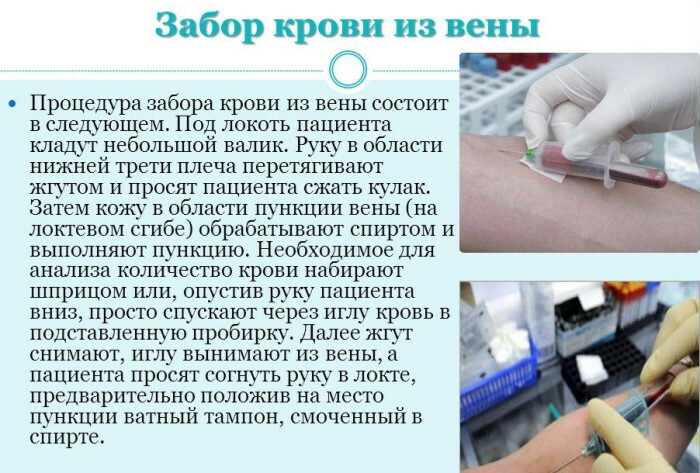
The algorithm for taking blood from a vein using a vacuum system includes the following steps:
- prepare test tubes, needle, holder, alcohol-soaked napkins, plaster;
- put a tourniquet on the diaper or shirt sleeve just above the site of the future puncture;
- the little patient needs to be explained that he must work with a cam;
- find the place of blood sampling: the elbow, the back of the hand;
- the specialist picks up the needle and removes the rubber cap from the side of the membrane;
- insert the needle into the holder and screw it in until it stops;
- disinfect the puncture site;
- remove the protective cap, insert the vacuum system into the vein, be sure to ensure that the cut is located upwards at an angle of 15 degrees in relation to the surface of the skin, make sure that the needle does not penetrate deeply into vein;
- insert the test tube all the way into the holder, as a result, the needle pierces the membrane and the plug, as a result of which a channel is formed between the test tube and the vein;
- do not move the needle while blood flows into the system;
- after stopping the flow of blood, the tube is removed from the holder, after which the membrane returns to its original position and the blood flow is blocked;
- if you need to take several analyzes, then you can insert a new tube;
- when the tube is full, turn it over. To mix the sample with the filler.
When all the tubes are full, the system is removed, the puncture site is treated with an antiseptic, and a bactericidal patch is glued on. The tubes are labeled and sent to the laboratory for research.
Tips for parents
It is not only the child that needs to be prepared for the blood draw.
Adults themselves must be mentally prepared for the procedure and know exactly how to behave in such a situation:
- Mom should remember that she must be completely calm. Children very much feel the mood of their parents, if the mother is afraid of the upcoming procedure, then this anxiety is transmitted to her child. With a child who already goes to kindergarten and understands everything, it is better to first discuss what will happen in the doctor's office. In no case should you frighten, especially if this procedure is the first in his life. One can only warn that unpleasant sensations can accompany the child.
- Parents should make sure that the child does not get bored while sitting in line. You can take with you his favorite book or toy, coloring book. This will not only notice the baby, but also allow you to forget about the upcoming procedure and relax.
- Parents accompanying the baby should decide whether they need to be personally present during the procedure. Mom must be present if the child is still small, but if the child already goes to the garden and more independent, the presence of a loved one during the procedure can provoke tears or protest. In search of an answer to the question of whether or not parents should be present in the office, it is worth knowing whether the child can be left alone with a stranger.
- It is better to hold a child in 1-2 years during the procedure. The child, feeling the care and warmth of the mother, reflexively calms down even in an unfamiliar and frightening atmosphere.
- It is better to start the procedure for taking blood not immediately after entering the office, the child should be given time to look around and get acquainted with the situation, get acquainted with the person who will carry out the procedure.
Parents should also know what should not be done in any case when telling the baby about how the procedure for taking blood from a vein will take place:
- On the eve of the test, you should not utter the following phrases in the presence of the child: "you will be given a small ukolchik", "you will need to be patient a little", "you should not be afraid."
- Phrases such as "it doesn't hurt", "it's not scary", "don't be afraid" scare the kid very much. A psychological barrier is built inside him, and he can arrange a tantrum in the specialist's office even before the procedure is started.
Vein bleeding is not a very pleasant procedure. Many adults are afraid of her, and there is even no need to talk about children. But if you foresee everything in advance, prepare yourself mentally for an adult, then the procedure will take place quickly and without any harm to the baby.
Today, thanks to innovations, blood is taken from a vein very quickly and painlessly, because anesthetics are used to treat the puncture site, and the child does not feel pain. The analysis is important, you should not ignore it, experts know exactly how to make a fence correctly, because they have to do it a dozen times every day.
Video about blood from a vein to a child
How a doctor takes blood from a vein from a baby:

